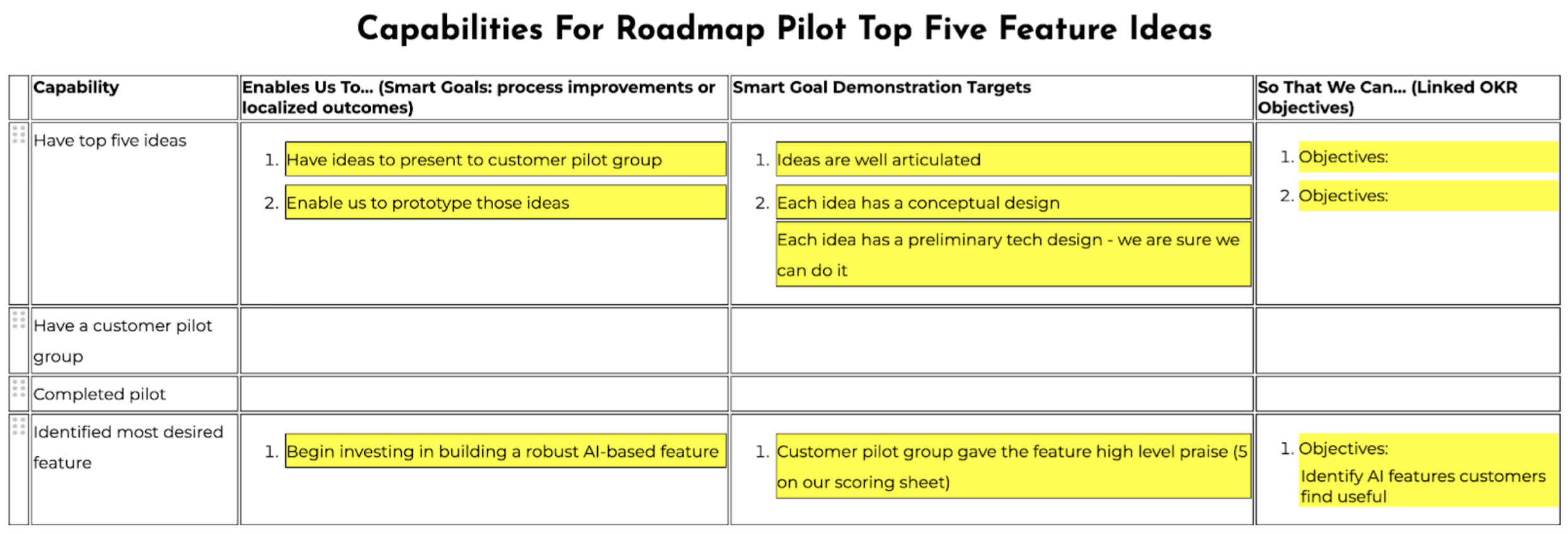Stay Aligned Through Rapid Change
Image credit: The Murmurations of Starlings - The Atlantic
Imagine that you have a set of complex initiatives underway.
Now imagine that things change in the market. (Remember when LLMs appeared on the scene? Remember when the tariffs started? Remember the pandemic?)
Suddenly, all your plans are in question – even your top level strategies.
You have to quickly update your strategies, and then align everyone.
Now imagine that all those complex initiatives have plans that look like this.
Good luck.
The problem is, you cannot see at a glance how things relate, especially across teams, let alone across business units.
The links between your objectives, strategies, and implementation goals are not visible in the plan. Instead, the plan is all about tasks. The objectives and strategies are not there.
Why Tasks Don’t Matter Very Much
Traditionally, tasking things out was how to get things done. We all learned to break work down into tasks, and then make sure that each task gets done. If every task gets done, then the whole initiative is done.
The problem is that this task-based model was designed for work that is easily decomposed into tasks. Product development is not like that: it is highly creative. This extends to the technical design as well. When engineers (or programmers) begin designing something, they don’t know what the final design will be. Thus, they don’t know what the pieces are – they have to design them. But the tasks will depend on the pieces.
So creating a complete task list is impossible for engineering, programming, or any creative work. At best, one can define some of the tasks, but nowhere near all of them. So a project plan that is task-based will be extremely incomplete. It will also be inaccurate, because engineers (and programmers) often change their approach mid-way into the work. That is not incompetence – it is normal and natural.
Also, speed matters today more than ever. We can no longer afford to be gridlocked into a maze of tasks when things change. We need to be able to rapidly realign around new objectives and new strategies.
How Streamline Helps You To Pivot Rapidly
Streamline doesn’t track tasks. Team members can define tasks, but those tasks are not part of the plan, which we call a Roadmap. The roadmap only contains high level things. Those things are the capabilities that need to be created.
For example, suppose that a key business strategy is to improve a product so that it now provides AI features.
Suppose that you create a team to solve that problem. The team might begin with an objective, to identify what the AI features should be – what would customers actually find useful and generate product loyalty? They can also define “key results” for that objective (not shown below).
The team might then devise some strategies for resolving that objective. For example, a strategy might be to brainstorm a set of top five feature ideas, prototype those, and then test them with real customers.
The team can link the objective to a strategy in the higher level strategy. (Not shown.) That way, there is line of sight between these things.
The team can then create a roadmap – a high level plan – for implementing their strategy. The roadmap might include milestones such as the four shown below in green boxes:
This is where the rubber meets the road. The arrows show dependency. For example, the second milestone depends on the first one.
But how do you know if you have really achieved these things? We can define smart goals for them.
In this screen shot, you can see that each capability from the roadmap is listed as a row in a table. Each row can have as many smart goals as you desire. And each smart goal can have multiple criteria for success.
Also, a smart goal can be linked to an objective in our team mission. In the screen shot above, check out the last row in the last column: the smart goal is linked to the objective “Identify AI features customers find useful”. That provides line of sight to our objectives.
So we see that we have linked our team’s objective,
Identify AI features customers find useful
to a corporate strategy,
Improve our product so that it now provides AI features
We have also defined a roadmap for doing this, which defined outcome-based milestones,
Have top five ideas
Have a customer pilot group
Completed pilot
Identified most desired feature
and we have defined smart goals for each of those milestones.
Nowhere have we defined any tasks.
We need tasks however. But the tasks are the province of the team. They can define tasks to their heart’s content: each milestone can have tasks attached to it. Below we show some possible tasks for the first milestone:
But those tasks are not used in planning outside of the team itself. Discussion between the team and others outside the team are focused on goals, milestones, strategies, objectives, and issues that are impacting whether the goals can be met.
By the way, if you want to find out how soon something can be done, Streamline has features galore for that, but that’s tangential to what we are talking about here.
This taskless project focus empowers people. They are in charge of figuring out how to get the work done – how to meet the objectives.
This does not mean that managers cannot discuss tasks with team members – they can of course. All they have to do is click on an item in the roadmap and select “Show tasks”. But goals and milestones are front-and-center. Effective leaders know when to dive into how things are being done (the tasks), and when not to. In a traditional project plan, all of the “how” is up front; in Streamline, what is up front is the collection of goals, milestones, objectives, and strategies.
The focus on goals and objectives makes it much easier to shift when a shift is needed. One has direct line of sight to strategies, and what those strategies are for – the attached objectives. And one can see at a glance what goals serve each milestone, and which objective is being served. The tasking and new estimates can be figured out by the team. And the roadmap makes it clear what depends on what, so that dependencies can be taken into account.
The whole point is to be able to move quickly and pivot quickly and adeptly. Focusing on goals, milestones, objectives, and strategies is how to enable rapid pivots.
That’s true agility, and effectiveness in a time of rapid change.
Consider trying Streamline in an initiative. We can help you get the most out of it. Not only will it free your managers and team leads to actually lead, but it will help to shift the culture as well, from one that is focused on tasks to one that is focused on issues, outcomes, and moving quickly.







